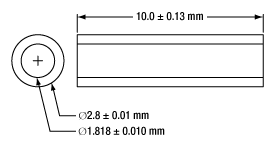
Single Wavelength Graded-Index (GRIN) Lenses
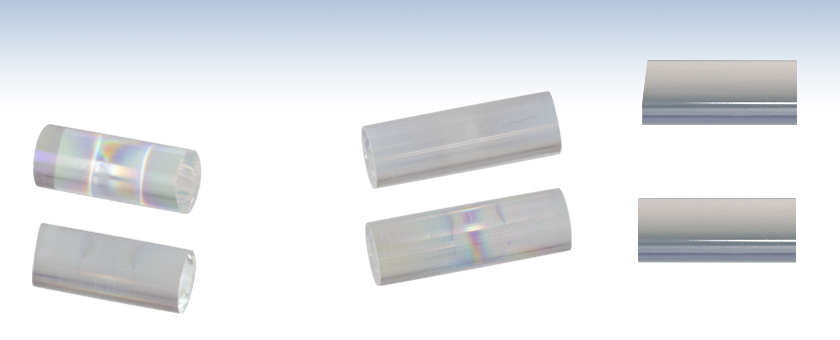
- Graded-Index Lenses for Collimation and Focusing
- Design Wavelengths: 630, 780, 830, 980, 1060, 1300, or 1560 nm
- Smaller Alternative to Aspheric Lenses
- 8° or 0° Face Angle
GRIN2309AC
GRIN2910AC
GRIN2907C
GRIN2909C
8º Face Angle
0º Face Angle
OVERVIEW
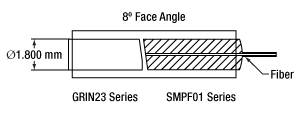
Click to Enlarge
Figure 1.1 8° Face Angle GRIN23 Series Lens and SMPF01 Series
Pigtailed Ferrule Coupled with a 51-2800-1800
Mating Sleeve (Sold Below)
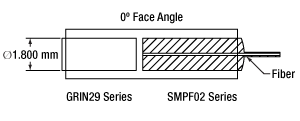
Click to Enlarge
Figure 1.2 0° Face Angle GRIN29 Series Lens and SMPF02 Series
Pigtailed Ferrule Coupled with a 51-2800-1800
Mating Sleeve (Sold Below)
| Click on the red Document icon next to the item numbers below to access the Zemax file download. Our entire Zemax Catalog is also available. |
Features
- Provides Collimation and Focusing of Fiber-Coupled Light
- Designed for Easy Integration with Pigtailed Ferrules
- Uncoated and AR Coated Options Available
- 8° or 0° Face Angle
- 0.23 or 0.29 Pitch
Thorlabs' family of single wavelength graded-index (GRIN) lenses has been specially designed to be paired with our bare or single mode (SM) with connectors or our polarization-maintaining (PM) with connectors pigtailed ferrules. In contrast to our pigtailed aspheric lenses and jacketed GRIN collimators, this product family allows the combination of GRIN lens and optionally terminated pigtailed ferrule to be individually chosen, satisfying a wide range of experimental requirements. Please see the Collimator Assembly tab for all GRIN lenses that are compatible with our pigtailed ferrules. We also offer GRIN lenses for imaging applications.
GRIN lenses are generally used to collimate or reimage the output of a fiber. Typical applications include coupling the output of diode lasers into fibers, focusing laser light onto a detector, or collimating laser light. The lenses listed here are designed for a central wavelength of 630, 780, 830, 980, 1060, 1300, or 1560 nm, and are available with either an 8° or 0° face angle. The 8° versions maximize the return loss by back reflecting the incident light at a non-normal angle and are recommended for building collimators. In contrast, the 0° versions are easier to align but are only recommended for general fiber-to-fiber coupling. Options are available for lenses with an AR coating that reduces reflections at the interfaces at the specified wavelengths, minimizing back reflections and insertion losses. Our line of pigtailed ferrules provides an 8° or 0° face angle that is designed to match the GRIN lenses.
GRIN lenses do not require an air gap to function since the operation of the lens is due to varying indices in the lens itself, rather than the difference in indices between the air and lens. However, the AR coatings on the GRIN lenses and pigtailed ferrules are optimized for a glass-air interface. Therefore, for AR-coated items, an air gap between two lenses or a lens and ferrule is recommended to prevent higher reflections caused by the glass-glass interface. For uncoated items, it is recommended to either put the items in optical contact or use index matching gel to prevent higher reflections. Additionally, in a GRIN lens, all optical paths (refractive index multiplied by distance) are the same due to the radially varying refractive index, in contrast to a spherical or aspheric lens. For information on how to calculate the refractive index as a function of radius, please see the Specs tab.
A ray incident on the front surface of a GRIN lens follows a sinusoidal path along the rod. The "pitch" of the lens is the fraction of a full sinusoidal period that the ray traverses in the lens (i.e., a lens with a pitch of 0.25 has a length equal to 1/4 of a sine wave, which would collimate a point source at the surface of the lens). Our GRIN lenses feature pitches of 0.23 and 0.29, which are just short of focus and just past focus, respectively. For ray diagrams detailing how lenses with different pitches are used, please see the Ray Diagrams tab.
SPECS

Figure 2.2 The 0.29 pitch lenses include 0° end faces.
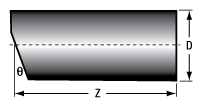
Figure 2.1 The 0.23 pitch lenses include an 8° angled facet to minimize back reflection and compensate for the angular beam deviation from angled fiber ferrules.
| Common Specifications | |
|---|---|
| Diameter (D)a | 1.8 mm |
| On-Axis NA (Half-Angle) | 0.23 |
| Polarization Preservation | 0.99% |
| Material | Oxide Glass |
| Item # | Pitcha (P) |
Face Angle (θ) | Design Wavelength | AR Coated | Transmittance | Effective Focal Lengthb | Length (Z) | Working Distancec | Index (n1) |
√A (mm-1) |
Operating Temperature |
|---|---|---|---|---|---|---|---|---|---|---|---|
| GRIN2306A | 0.23 | 8° | 630 nm | Yesd | >89%, 380 - 2000 nm |
1.85 mm | 4.26 mm | 0.234 mm | 1.6073 | 0.339 | <350 °C |
| GRIN2307AC | 0.23 | 8° | 780 nm | Yesd | >97%, 780 ± 15 nm |
1.89 mm | 4.33 mm | 0.238 mm | 1.601 | 0.334 | 200°C x 1000 hrs |
| GRIN2308A | 0.23 | 8° | 830 nm | No | >89%, 380 - 2000 nm |
1.90 mm | 4.35 mm | 0.239 mm | 1.5986 | 0.332 | <350 °C |
| GRIN2308AC | 0.23 | 8° | 830 nm | Yesd | >97%, 830 ± 15 nm |
1.90 mm | 4.34 mm | 0.239 mm | 1.599 | 0.332 | 200°C x 1000 hrs |
| GRIN2309AC | 0.23 | 8° | 980 nm | Yese | >97%, 980 ± 30 nm |
1.91 mm | 4.36 mm | 0.239 mm | 1.597 | 0.330 | 200°C x 1000 hrs |
| GRIN2310A | 0.23 | 8° | 1060 nm | No | >89%, 380 - 2000 nm |
1.92 mm | 4.39 mm | 0.238 mm | 1.5940 | 0.329 | <350 °C |
| GRIN2310AC | 0.23 | 8° | 1060 nm | Yesd | >97%, 1060 ± 30 nm |
1.92 mm | 4.37 mm | 0.238 mm | 1.594 | 0.329 | 200°C x 1000 hrs |
| GRIN2313A | 0.23 | 8° | 1300 nm | Yesf | >89%, 380 - 2000 nm |
1.94 mm | 4.42 mm | 0.242 mm | 1.5916 | 0.327 | <350 °C |
| GRIN2315A | 0.23 | 8° | 1560 nm | Yesf | >89%, 380 - 2000 nm |
1.94 mm | 4.43 mm | 0.245 mm | 1.5901 | 0.326 | <350 °C |
| GRIN2906 | 0.29 | 0° | 630 nm | No | >89%, 380 - 2000 nm |
1.90 mm | 5.37 mm | 1.411 mm | 1.6073 | 0.339 | <350 °C |
| GRIN2906C | 0.29 | 0° | 630 nm | Yesd | >97%, 630 ± 15 nm |
1.90 mm | 5.37 mm | 1.411 mm | 1.607 | 0.339 | 200°C x 1000 hrs |
| GRIN2907C | 0.29 | 0° | 780 nm | Yesd | >97%, 780 ± 15 nm |
1.93 mm | 5.46 mm | 1.440 mm | 1.601 | 0.334 | 200°C x 1000 hrs |
| GRIN2908 | 0.29 | 0° | 830 nm | No | >89%, 380 - 2000 nm |
1.95 mm | 5.49 mm | 1.449 mm | 1.5986 | 0.332 | <350 °C |
| GRIN2908C | 0.29 | 0° | 830 nm | Yesd | >97%, 830 ± 15 nm |
1.95 mm | 5.47 mm | 1.449 mm | 1.599 | 0.332 | 200°C x 1000 hrs |
| GRIN2909C | 0.29 | 0° | 980 nm | Yese | >97%, 980 ± 30 nm |
1.96 mm | 5.50 mm | 1.459 mm | 1.597 | 0.330 | 200°C x 1000 hrs |
| GRIN2910 | 0.29 | 0° | 1060 nm | No | >89%, 380 - 2000 nm |
1.97 mm | 5.54 mm | 1.471 mm | 1.5940 | 0.329 | <350 °C |
| GRIN2910C | 0.29 | 0° | 1060 nm | Yesd | >97%, 1060 ± 30 nm |
1.97 mm | 5.51 mm | 1.471 mm | 1.594 | 0.329 | 200°C x 1000 hrs |
| GRIN2913 | 0.29 | 0° | 1300 nm | Yesf | >89%, 380 - 2000 nm |
1.98 mm | 5.57 mm | 1.480 mm | 1.5916 | 0.327 | <350 °C |
| GRIN2915 | 0.29 | 0° | 1560 nm | Yesf | >89%, 380 - 2000 nm |
1.99 mm | 5.59 mm | 1.485 mm | 1.5906 | 0.326 | <350 °C |

Figure 2.3 GRIN Refractive Index Profile
Index as a Function of Radius
The index as a function of radius, as shown in Figure 2.3, may be calculated with the equation:
where n1 is the index of refraction on the optical axis, √A is the gradient constant, and r is the radial position (ranging from -D/2 to +D/2, where D is the diameter).
Relating Pitch and Lens Length
The pitch and length of a GRIN lens may be related using the following equation:
where P is the pitch of the lens and Z is the length of the lens.
RAY DIAGRAMS
The following ray diagrams are results from ZEMAX and are designed to show the uses of Thorlabs' GRIN lenses for various fiber coupling and collimating applications. For more details on the suitablilty for a GRIN lens to a particular application, please contact Technical Support.
GRIN Lenses with Pitch = 0.23

Click to Enlarge

Click to Enlarge

Click to Enlarge

Click to Enlarge
GRIN Lenses with Pitch = 0.29

Click to Enlarge
Figure 3.2 Theorectical Spot Size and Irrandiance for the 1:1 Coupling shown in Figure 3.1
COLLIMATOR ASSEMBLY

Click for Details
Figure 4.1 GRIN Lens, Sleeve, and Pigtailed Ferrule
(Each Sold Separately)

Click to Enlarge
Figure 4.3 We Recommend Using a UV Cured Optical Adhesive When Connecting these Parts
Using GRIN Lenses to Collimate Pigtailed Ferrules
All pigtailed ferrules can be collimated using our selection of GRIN Lenses along with a 51-2800-1800 mating sleeve, available below. This collimator can be assembled by inserting the lens and ferrule into opposing sides of the mating sleeve as shown in Figures 4.1 and 4.3. Gently bring them into contact to ensure that the faces are parallel, then bring the lens and ferrule apart until the desired focusing is achieved. For ease of assembly, we recommend using our spring-loaded micro V-clamp or tweezers to handle these small cylindrical components.
The SMPF01 and PMPFX series of pigtailed glass ferrules have an 8° face angle which is compatible with the 8° face angle of the GRIN23 series of lenses. The SMPF02 series of ferrules have a 0° face angle which is compatible with the 0° face angle of the GRIN29 lens series.
Use Table 4.2 to select between our PM and SM pigtailed ferrules and the corresponding compatible GRIN lenses. Our PM glass ferrules are offered with FC/PC or FC/APC connectors while our SM ferrules are offered with both of these connector types or without a connector.
| Table 4.2 Selection Guide | |||||||
|---|---|---|---|---|---|---|---|
| Wavelength | Face Angle | Compatible GRIN Lensesa |
PM Pigtailed Ferrule | SM Pigtailed Ferrule | |||
| FC/PC | FC/APC | FC/PC | FC/APC | No Connector | |||
| 630 nm | 8° | GRIN2306A | PMPFX1 | PMPFX4 | - | - | - |
| 0° | GRIN2906 GRIN2906C |
- | - | - | - | - | |
| 633 nm | 8° | GRIN2306A | - | - | SMPF0106-FC | SMPF0106-APC | SMPF0106 |
| 0° | GRIN2906 GRIN2906C |
- | - | SMPF0206-FC | SMPF0206-APC | SMPF0206 | |
| 780 nm | 8° | GRIN2307AC | PMPFX2 | PMPFX5 | - | - | - |
| 0° | GRIN2907C | - | - | - | - | - | |
| 830 nm | 8° | GRIN2308A GRIN2308AC |
- | - | SMPF0108-FC | SMPF0108-APC | SMPF0108 |
| 0° | GRIN2908 GRIN2908C |
- | - | SMPF0208-FC | SMPF0208-APC | SMPF0208 | |
| 980 nm | 8° | GRIN2309AC | PMPFX7 | PMPFX9 | - | - | - |
| 0° | GRIN2909C | - | - | - | - | - | |
| 1064 nm | 8° | GRIN2310A GRIN2310AC |
PMPFX8 | PMPFX10 | SMPF0110-FC | SMPF0110-APC | SMPF0110 |
| 0° | GRIN2910 GRIN2910C |
- | - | SMPF0210-FC | SMPF0210-APC | SMPF0210 | |
| 1310/1550 nm | 8° | GRIN2313A GRIN2315A |
- | - | SMPF0115-FC | SMPF0115-APC | SMPF0115 |
| 0° | GRIN2913 GRIN2915 |
- | - | SMPF0215-FC | SMPF0215-APC | SMPF0215 | |
| 1550 nm | 8° | GRIN2315A | PMPFX3 | PMPFX6 | - | - | - |
COLLIMATOR GUIDE
Fiber Collimator Selection Guide
Click on the collimator type or photo to view more information about each type of collimator.
| Type | Description | |
|---|---|---|
| Fixed FC, APC, or SMA Fiber Collimators | 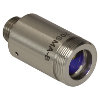 |
These fiber collimation packages are pre-aligned to collimate light from an FC/PC-, FC/APC-, or SMA-terminated fiber. Each collimation package is factory aligned to provide diffraction-limited performance for wavelengths ranging from 405 nm to 4.55 µm. Although it is possible to use the collimator at detuned wavelengths, they will only perform optimally at the design wavelength due to chromatic aberration, which causes the effective focal length of the aspheric lens to have a wavelength dependence. |
| Air-Spaced Doublet, Large Beam Collimators | 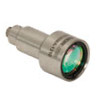 |
For large beam diameters (Ø5.3 - Ø8.5 mm), Thorlabs offers FC/APC, FC/PC, and SMA air-spaced doublet collimators. These collimation packages are pre-aligned at the factory to collimate a laser beam propagating from the tip of an FC or SMA-terminated fiber and provide diffraction-limited performance at the design wavelength. |
| Triplet Collimators | 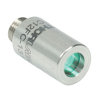 |
Thorlabs' High Quality Triplet Fiber Collimation packages use air-spaced triplet lenses that offer superior beam quality performance when compared to aspheric lens collimators. The benefits of the low-aberration triplet design include an M2 term closer to 1 (Gaussian), less divergence, and less wavefront error. |
| Achromatic Collimators for Multimode Fiber | 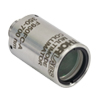 |
Thorlabs' High-NA Achromatic Collimators pair a meniscus lens with an achromatic doublet for high performance across the visible to near-infrared spectrum with low spherical aberration. Designed for use with high-NA multimode fiber, these collimators are ideal for Optogenetics and Fiber Photometry applications. |
| Reflective Collimators |  |
Thorlabs' metallic-coated Reflective Collimators are based on a 90° off-axis parabolic mirror. Mirrors, unlike lenses, have a focal length that remains constant over a broad wavelength range. Due to this intrinsic property, a parabolic mirror collimator does not need to be adjusted to accommodate various wavelengths of light, making them ideal for use with polychromatic light. Our fixed reflective collimators are recommended for collimating single and multimode fiber and coupling into multimode fiber. These collimators are available with UV-enhanced aluminum or protected silver reflective coatings and with FC/PC, FC/APC, or SMA connector compatibility. |
| Compact Reflective Collimators | 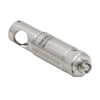 |
Thorlabs' Compact Reflective Collimators incorporate a 90° off-axis parabolic mirror with a protected silver coating. Because the focal length is independent of wavelength for an off-axis parabolic mirror, they are ideal for use with polychromatic light. Our fixed reflective collimators are recommended for collimating single and multimode fiber and coupling into multimode fiber. These collimators are directly compatible with our 16 mm cage system. They are available with FC/PC, FC/APC, or SMA connector inputs. |
| Adjustable Reflective Collimators | 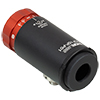 |
Thorlabs' Adjustable Focus Reflective Collimators use a 90° off-axis parabolic (OAP) mirror with a protected silver coating to collimate light from a fiber or couple light into a fiber. The adjustable fiber-to-OAP distance, combined with the OAP having a constant focal length across wavelengths, makes these collimators ideal for optimizing collimation or coupling of polychromatic light with single mode or multimode fiber. These adjustable collimators have a 15.0 mm or 33.0 mm reflected focal length and are available with FC/PC, FC/APC, or SMA connectors. |
| Polaris Kinematic, Fixed Focus Collimators |  |
Polaris® Kinematic, Fixed Focus Collimators combine the high-quality beam output of our fixed focus collimation packages with the remarkable mechanical properties of our Polaris® mounts, making them the ultimate solution for fiber collimation applications requiring stringent long-term alignment stability. These fiber collimation packages are pre-aligned to collimate light from an FC/PC-terminated fiber with diffraction-limited performance at one of four alignment wavelengths between 532 nm and 850 nm. |
| FiberPorts | 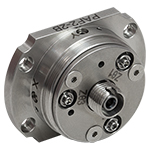 |
These compact, ultra-stable FiberPort micropositioners provide an easy-to-use, stable platform for coupling light into and out of FC/PC, FC/APC, or SMA terminated optical fibers. It can be used with single mode, multimode, or PM fibers and can be mounted onto a post, stage, platform, or laser. The built-in aspheric or achromatic lens is available with five different AR coatings and has five degrees of alignment adjustment (3 translational and 2 pitch). The compact size and long-term alignment stability make the FiberPort an ideal solution for fiber coupling, collimation, or incorporation into OEM systems. |
| Adjustable Fiber Collimators |  |
These collimators are designed to connect onto the end of an FC/PC, FC/APC, or SMA connector and contain an AR-coated aspheric lens. The distance between the aspheric lens and the tip of the fiber can be adjusted to compensate for focal length changes or to recollimate the beam at the wavelength and distance of interest. |
| Achromatic Fiber Collimators with Adjustable Focus |  |
Thorlabs' Achromatic Fiber Collimators with Adjustable Focus are designed with an effective focal length (EFL) of 20 mm, 40 mm, or 80 mm, have optical elements broadband AR coated for one of three wavelength ranges, and are available with FC/PC, FC/APC, or SMA905 connectors. A four-element, air-spaced lens design produces superior beam quality (M2 close to 1) and less wavefront error when compared to aspheric lens collimators. These collimators can be used for free-space coupling into a fiber, collimation of output from a fiber, or in pairs for collimator-to-collimator coupling over long distances, which allows the beam to be manipulated prior to entering the second collimator. |
| Zoom Fiber Collimators | 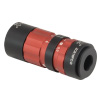 |
These collimators provide a variable focal length between 6 and 18 mm, while maintaining the collimation of the beam. As a result, the size of the beam can be changed without altering the collimation. This universal device saves time previously spent searching for the best suited fixed fiber collimator and has a very broad range of applications. They are offered with FC/PC, FC/APC, or SMA905 connectors with three different antireflection wavelength ranges to choose from. |
| Single Mode Pigtailed Collimators | 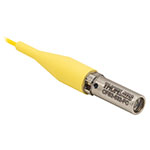 |
Our single mode pigtailed collimators come with one meter of fiber, consist of an AR-coated aspheric lens pre-aligned with respect to a fiber, and are collimated at one of eight wavelengths: 532 nm, 633 nm, 780 nm, 850 nm, 1030 nm, 1064 nm, 1310 nm, or 1550 nm. Although it is possible to use the collimator at any wavelength within the coating range, the coupling loss will increase as the wavelength is detuned from the design wavelength. |
| Polarization Maintaining Pigtailed Collimators |  |
Our polarization maintaining pigtailed collimators come with one meter of fiber, consist of an AR-coated aspheric lens pre-aligned with respect to a fiber, and are collimated at one of five wavelengths: 633 nm, 780 nm, 980 nm, 1064 nm, or 1550 nm. Custom wavelengths and connectors are available as well. A line is engraved along the outside of the housing that is parallel to the fast axis. As such, it can be used as a reference when polarized light is launched accordingly. Although it is possible to use the collimator at any wavelength within the coating range, the coupling loss will increase as the wavelength is detuned from the design wavelength. |
| GRIN Fiber Collimators | 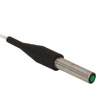 |
Thorlabs offers gradient index (GRIN) fiber collimators that are aligned at a variety of wavelengths from 630 to 1550 nm and have either FC terminated, APC terminated, or unterminated fibers. Our GRIN collimators feature a Ø1.8 mm clear aperture, are AR-coated to ensure low back reflection into the fiber, and are coupled to standard single mode or graded-index multimode fibers. |
| GRIN Lenses | 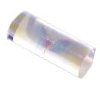 |
These graded-index (GRIN) lenses are AR coated for applications at 630, 830, 1060, 1300, or 1560 nm that require light to propagate through one fiber, then through a free-space optical system, and finally back into another fiber. They are also useful for coupling light from laser diodes into fibers, coupling the output of a fiber into a detector, or collimating laser light. Our GRIN lenses are designed to be used with our Pigtailed Glass Ferrules and GRIN/Ferrule sleeves. |
Single Wavelength GRIN Lenses, 8° Face Angle
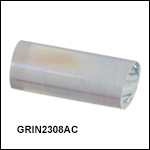
These GRIN lenses have an 8° face angle and are designed for use at 630, 780, 830, 980, 1060, 1300, or 1560 nm. Both uncoated and AR coated options are available. The 8° face angle maximizes the return loss by back reflecting the incident light at a non-normal angle and are recommended for building collimators. The 1300 nm and 1560 nm lenses are particularly suited for telecom applications due to their ease of use with small beams and negligible chromatic aberration over telecom wavelengths.
| Item #a | Design Wavelength | AR Coating | Pitch | Face Angle | Effective Focal Lengthb | Working Distancec |
|---|---|---|---|---|---|---|
| GRIN2306A | 630 nm | 630 nm | 0.23 | 8° | 1.85 mm | 0.234 mm |
| GRIN2307AC | 780 nm | 780 nmd | 1.89 mm | 0.238 mm | ||
| GRIN2308A | 830 nm | N/A | 1.90 mm | 0.239 mm | ||
| GRIN2308AC | 830 nm | 830 nmd | 1.90 mm | 0.239 mm | ||
| GRIN2309AC | 980 nm | 980 nme | 1.91 mm | 0.239 mm | ||
| GRIN2310A | 1060 nm | N/A | 1.92 mm | 0.238 mm | ||
| GRIN2310AC | 1060 nm | 1060 nmd | 1.92 mm | 0.238 mm | ||
| GRIN2313A | 1300 nm | 1250 - 1650 nmf | 1.94 mm | 0.242 mm | ||
| GRIN2315A | 1560 nm | 1250 - 1650 nmf | 1.94 mm | 0.245 mm |
Part Number | Description | Price | Availability |
|---|---|---|---|
GRIN2306A | GRIN Lens, Ø1.8 mm, 0.23 Pitch, 8°, 630 nm Design Wavelength, AR Coated: 630 nm | $53.39 | Today |
GRIN2307AC | GRIN Lens, Ø1.8 mm, 0.23 Pitch, 8°, 780 nm Design Wavelength, AR Coated: 780 nm | $56.71 | Today |
GRIN2308A | GRIN Lens, Ø1.8 mm, 0.23 Pitch, 8°, 830 nm Design Wavelength, Uncoated | $53.39 | Today |
GRIN2308AC | GRIN Lens, Ø1.8 mm, 0.23 Pitch, 8°, 830 nm Design Wavelength, AR Coated: 830 nm | $56.71 | Today |
GRIN2309AC | GRIN Lens, Ø1.8 mm, 0.23 Pitch, 8°, 980 nm Design Wavelength, AR Coated: 980 nm | $63.13 | Today |
GRIN2310A | GRIN Lens, Ø1.8 mm, 0.23 Pitch, 8°, 1060 nm Design Wavelength, Uncoated | $53.39 | Today |
GRIN2310AC | GRIN Lens, Ø1.8 mm, 0.23 Pitch, 8°, 1060 nm Design Wavelength, AR Coated: 1060 nm | $56.71 | Today |
GRIN2313A | GRIN Lens, Ø1.8 mm, 0.23 Pitch, 8°, 1300 nm Design Wavelength, AR Coated: 1250 - 1650 nm | $46.40 | Today |
GRIN2315A | GRIN Lens, Ø1.8 mm, 0.23 Pitch, 8°, 1560 nm Design Wavelength, AR Coated: 1250 - 1650 nm | $46.40 | Today |
Single Wavelength GRIN Lenses, 0° Face Angle
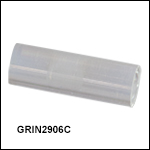
These GRIN lenses have a 0° face angle and are designed for use at 630, 780, 830, 980, 1060, 1300, or 1560 nm. Both uncoated and AR coated options are available. They are easy to align and are recommended for general fiber-to-fiber coupling. The 1300 nm and 1560 nm lenses are particularly suited for telecom applications due to their ease of use with small beams and negligible chromatic aberration over telecom wavelengths.
| Item #a | Design Wavelength | AR Coating | Pitch | Face Angle | Effective Focal Lengthb | Working Distancec |
|---|---|---|---|---|---|---|
| GRIN2906 | 630 nm | N/A | 0.29 | 0° | 1.90 mm | 1.411 mm |
| GRIN2906C | 630 nm | 630 nmd | 1.90 mm | 1.411 mm | ||
| GRIN2907C | 780 nm | 780 nmd | 1.93 mm | 1.440 mm | ||
| GRIN2908 | 830 nm | N/A | 1.95 mm | 1.449 mm | ||
| GRIN2908C | 830 nm | 830 nmd | 1.95 mm | 1.449 mm | ||
| GRIN2909C | 980 nm | 980 nme | 1.96 mm | 1.459 mm | ||
| GRIN2910 | 1060 nm | N/A | 1.97 mm | 1.471 mm | ||
| GRIN2310C | 1060 nm | 1060 nmd | 1.97 mm | 1.471 mm | ||
| GRIN2913 | 1300 nm | 1250 - 1650 nmf | 1.98 mm | 1.480 mm | ||
| GRIN2915 | 1560 nm | 1250 - 1650 nmf | 1.99 mm | 1.485 mm |
Part Number | Description | Price | Availability |
|---|---|---|---|
GRIN2906 | GRIN Lens, Ø1.8 mm, 0.29 Pitch, 0°, 630 nm Design Wavelength, Uncoated | $47.66 | Today |
GRIN2906C | GRIN Lens, Ø1.8 mm, 0.29 Pitch, 0°, 630 nm Design Wavelength, AR Coated: 630 nm | $52.43 | Today |
GRIN2907C | GRIN Lens, Ø1.8 mm, 0.29 Pitch, 0°, 780 nm Design Wavelength, AR Coated: 780 nm | $52.43 | Today |
GRIN2908 | GRIN Lens, Ø1.8 mm , 0.29 Pitch, 0°, 830 nm Design Wavelength, Uncoated | $47.66 | Today |
GRIN2908C | GRIN Lens, Ø1.8 mm, 0.29 Pitch, 0°, 830 nm Design Wavelength, AR Coated: 830 nm | $52.43 | Today |
GRIN2909C | GRIN Lens, Ø1.8 mm, 0.29 Pitch, 0°, 980 nm Design Wavelength, AR Coated: 980 nm | $57.78 | Today |
GRIN2910 | GRIN Lens, Ø1.8 mm, 0.29 Pitch, 0°, 1060 nm Design Wavelength, Uncoated | $47.66 | Today |
GRIN2910C | GRIN Lens, Ø1.8 mm, 0.29 Pitch, 0°, 1060 nm Design Wavelength, AR Coated: 1060 nm | $52.43 | Today |
GRIN2913 | GRIN Lens, Ø1.8 mm, 0.29 Pitch, 0°, 1300 nm Design Wavelength, AR Coated: 1250 - 1650 nm | $45.13 | Today |
GRIN2915 | GRIN Lens, Ø1.8 mm, 0.29 Pitch, 0°, 1560 nm Design Wavelength, AR Coated: 1250 - 1650 nm | $45.13 | Today |
GRIN Lens / Ferrule Sleeves
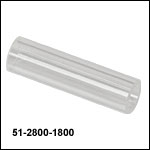
- Borosilicate Glass
- 10.0 mm Length
- 1.818 mm Internal Diameter
The 51-2800-1800 sleeve is designed to easily mate any one of our GRIN lenses to a single mode (item # prefix SMPF) or polarization-maintaining (item # prefix PMPF) pigtailed glass ferrule. The borosilicate glass is transparent to UV light, allowing curing of NOA68 or NOA61 optical adhesive inside the sleeve. See here for our complete selection of optical adhesives.
Part Number | Description | Price | Availability |
|---|---|---|---|
51-2800-1800 | GRIN/Ferrule Sleeve, 1.818 mm Internal Diameter, 10 mm Length, Borosilicate Glass | $7.69 | In Stock Overseas |


